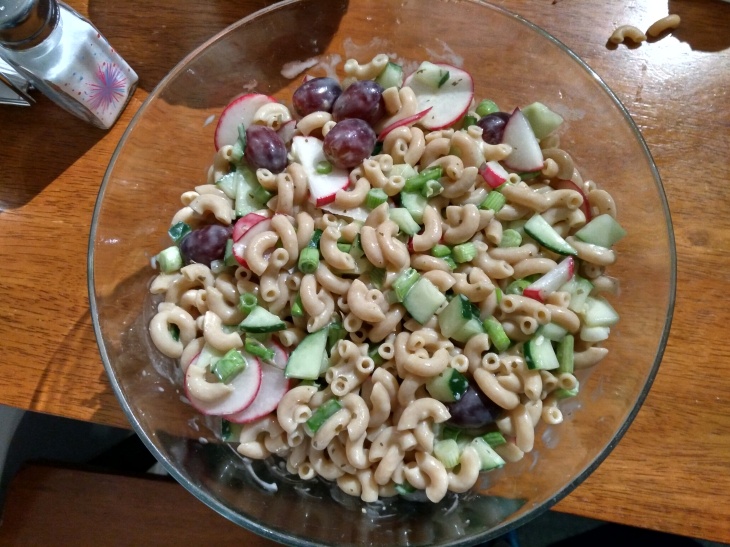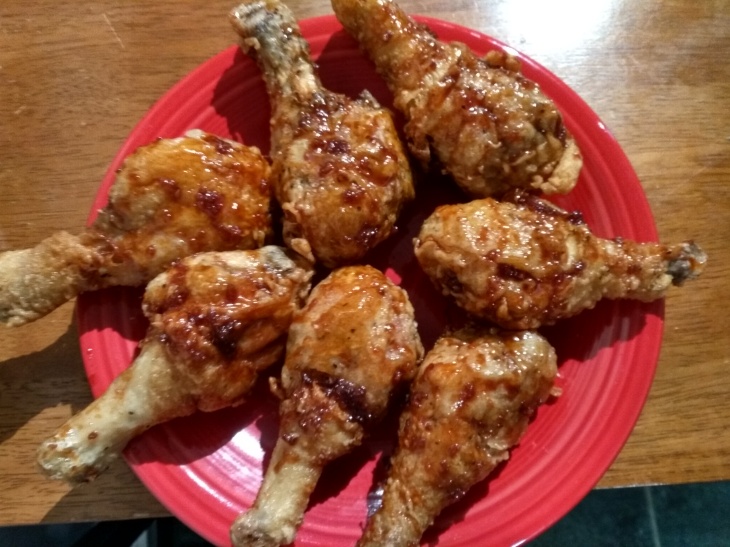Kristina:
John’s had a busy day, so I’m going to commandeer the blog… just for today.

Whew. Now that I got the meme-ing out of my system, let’s get down to business.
Today was Monday – the day I agreed to cook dinner for my entire family. The day I had to come up with something macrobiotic that would still please a passel of picky palates (if you think that’s hard to say, try doing it!). But I had made the commitment, and to back out now would be cowardly surrender at best, dark treachery at worst.
But now, as I sit here typing and sipping my tulsi tea, I can smile about the whole thing. Because, with a little help, it turned out just fine. Better than fine, actually, if multiple compliments mean anything.
So, let’s review my plan of attack and its execution.
Last night, I scoured a stack of recipes for ones that would make up a full meal for my family and could be tweaked to conform to macrobiotics. I also knew my family wouldn’t care for a meal unless it had real meat (no tofu) and was tasty and well-mixed (no eggplant “pizzas”). At last, I found two in a recent issue of the Food Network magazine: one for Korean fried chicken and one for “Katie Lee’s Macaroni Salad.”
At first glance, these two dishes sound anything but macrobiotic. However, with a little strategic sleight-of-hand, it was easy to replace several questionable ingredients with better substitutes. I was flying a little blind and had only a couple hours to buy needed ingredients and make the meal, so some things I kept in may not have been the best options (e.g., I had doubts about cornstarch but ended up using it), but the main takeaway of this post is not just the meal itself, but how to substitute ingredients even in a complex recipe.
For sake of space, let me present the recipes below with the substitutes indicated. As stated, the original recipes came from the Food Network magazine, but the revamped recipes tasted just as amazing as I imagine the originals would have (and my family would agree… which is saying a lot). To pull off both of these recipes in less than two hours, I also enlisted the help of my dad, who is an experienced cook, and we were both working constantly the whole time. So if you’re planning a meal this complicated in a short time frame, I’d recommend prepping and setting ingredients aside beforehand and possibly getting an assistant chef.
Almost-Korean Fried Chicken
- 3 pounds chicken drumsticks or split wings (tips removed)
- Kosher salt and freshly ground pepper (use less salt than indicated in directions)
- 1/2 cup plus 1/3 cup cornstarch (I didn’t change this, but rice starch, tapioca starch, and arrowroot are all possible substitutes)
- 1/2 teaspoon baking powder
- 2 tablespoons
vegetableolive or peanut oil, plus more for frying (about 10 cups) - 4 cloves garlic, minced (used fresh garlic, it was awesome)
- 2 teaspoons grated peeled fresh ginger
- 1/4 cup
low sodiumsoy sauce 1/4 cup packed dark brown sugar- 2 tablespoons honey
- 2 teaspoons
riceapple cider vinegar (rice is fine, but I couldn’t find any in time) - 1 teaspoon Sriracha
- 1 teaspoon toasted sesame oil
- 1/3 cup
all-purposewhole wheat flour 1/3 cup vodka1/3 + 1/3 cup water (didn’t get to track down vodka either)- Toasted sesame seeds, for sprinkling (also ran out of time, but would recommend)
TIME: 1 hr | SERVES: 4 to 6
1. Toss the chicken with 2 tsp. salt (use less because of soy sauce) and 1/2 tsp. pepper. Whisk 1/2 cup cornstarch and 1/4 tsp. baking powder in a medium bowl. Coat the chicken in the cornstarch mixture, shaking off any excess. Transfer to a rack set on a baking sheet and let sit, uncovered, to set the coating, 30 minutes.
2. Meanwhile, heat 2 tbsp. peanut oil in a small saucepan over medium heat. Add the garlic and ginger and cook, stirring, until just softened but not browned, about 2 minutes. Add the soy sauce, honey, vinegar, Sriracha, and sesame oil; bring to a simmer and cook until slightly thickened, 6 to 8 minutes. Set the sauce aside.
3. Fill a large Dutch oven or other heavy pot with 2 to three inches of oil. (We ended up mixing peanut and olive oil and topping off with vegetable to get enough. It turned out fine, but probably not recommended.) Heat over medium heat until a deep-fry thermometer registers 350*. Whisk the flour, remaining 1/3 cup cornstarch and 1/4 tsp. baking powder and 2 pinches of salt in a medium bowl. Add the 23 cup cold water and whisk until the batter is smooth and very thin (about the consistency of half-and-half). If needed, add more water, 1 tbsp. at a time, to thin the batter.
4. One at a time, dip about half the chicken pieces in the batter, letting any excess drip off. Then, using tongs, hold the chicken halfway in the hot oil for 1 to 2 seconds before letting go completely (this will prevent it from sticking to the bottom of the pot). If any pieces stick together, gently separate them with the tongs. The oil temperature will drop. adjust the heat as necessary to maintain a temperature between 300* and 325*. Fry the chicken until the coating is crisp but not browned, about 6 minutes. Remove to a rack set on a baking sheet to drain. (The chicken will not be fully cooked at this stage.) Let the oil temperature return to 350* before frying the remaining chicken.
5. Double-fry the chicken: Increase the oil temperature to 375*. Working in two batches, fry the chicken again until the coating is browned and very crisp, 4 to 6 minutes for wings and 6 to 8 minutes for drumsticks. Adjust the heat as necessary to maintain a temperature of 350*. Remove with tongs and transfer to a clean rack set on a baking sheet; brush all over with the sauce. Sprinkle with sesame seeds.
***Original authors’ note: “We used vodka in the batter for this chicken. It evaporates more quickly than water, so the crust gets extra crisp. The double-fry technique adds to the crunch, too.”

Not Katie Lee’s Macaroni Salad
TIME: 35 min | SERVES: 6
- Kosher salt
- 2 cups whole wheat elbow macaroni
- 1 cup
halved grape tomatoespurple grapes - 8 radishes, thinly sliced (ended up with 5)
1/2 green bell pepper, diceda roughly equivalent amount asparagus stalks, tender and pencil-thin, chopped- 6 scallions (white and light green parts only), thinly sliced
- 1/2 English cucumber, diced
- 1/2 cup
mayonnaisehealthy ranch or goddess dressing, preferably yogurt-based - 1 tablespoon apple cider vinegar
- 1 tablespoon
yellow mustardDijon mustard - 1 teaspoon
sugarhoney - 1/2 teaspoon garlic salt
- Freshly ground pepper
1. Bring a large pot of salted water to a boil. Add the macaroni and cook as the label directs until al dente. Drain and let cool.
2. In a small bowl, whisk the dressing with the vinegar, mustard, honey, and garlic salt. Place the macaroni, vegetables, and dressing in a Ziploc bag, leaving a little air inside. Seal and shake gently until fully mixed.
3. Season with salt and pepper (I left this out). Refrigerate until serving.
*****
This post was longer than usual, so let me sum up:
- Cooking something yummy and macrobiotic for a family is possible (although the above recipes are on the sliding scale of macrobiotic-ness).
- You have almost infinite tweaking power over a recipe, as long as you sort of know what you’re doing. (If you don’t, that’s great too; just try to save the practice for your personal meals. I learned how to tweak recipes by trying and failing many times.)
- Don’t worry if people question your methods. Mi padre was skeptical of all the substitutions I made to the recipe, but in the end, he loved the results.
- Cooking is stressful, but also fun, especially when it ends with your family telling you multiple times how great everything tastes. I don’t expect that every time, but knowing I’m capable of success helps me to keep trying.
Thanks for sticking around for this long, foodie post. I’m getting hungry again and might have to dig out some leftovers for a late snack…


